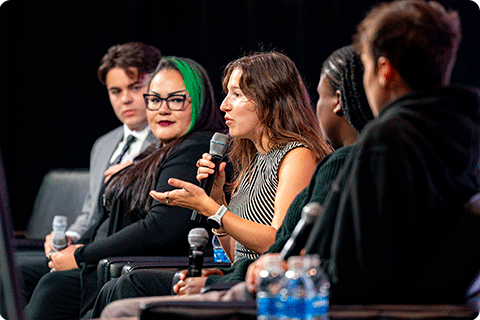
By Sam Rikkers
WEDC Deputy Secretary and Chief Operating Officer
Students helping to create a vision for their Northern Wisconsin town. Green Bay officials finding a way to build tiny homes for homeless veterans. And young leaders from around the state offering their insights to guide our state’s economic future.
These were some of the highlights for me at the fourth annual Wisconsin Economic Summit held last month in Green Bay, where business, community, and state and local government leaders exchanged ideas on how to overcome longstanding challenges and unlock investments in their communities.
We learned that in some cases, unlocking those investments meant building bridges between groups and individuals who shared a common goal.

Wally Leipart shares how the community in Gilman Wisconsin worked together to create a new vision for residents in their village.
In Gilman in Northern Wisconsin, the village and school district are working together to identify a “vision of hope and opportunity” to ensure the community continues to grow well into the future, said Wally Leipart, superintendent of the Gilman School District.
The goal for village officials, community members, and students was to “stay a small community but keep thriving,” Leipart said. He added that residents have embraced the effort once they discovered “we weren’t trying to come in and change Gilman into something that it doesn’t want to be.”
Other communities shared how even projects that many see as beneficial can generate resistance. Neighbors in Green Bay opposed plans to build a 21-unit housing development for veterans recovering from homelessness.
Will Peters, the city’s housing development specialist, explained how Green Bay officials quickly learned they needed to be transparent with community members, lead with the facts, and address concerns up front rather than avoid them.
While some neighbors remained opposed to the project, it ultimately moved forward as residents recognized “we were faced with the challenge of balancing the needs and wants of the neighborhood with the needs and wants of an entire community,” Peters said.
We also heard from a group of young leaders from around the state were eager to share the challenges they’re encountering entering the workforce. Whether it’s finding an affordable place to live, landing a job that provides an income and quality of life they desire, or delaying milestone moments in their lives, such as buying a house or new vehicle, a lot of their discussion focused on pocketbook issues.

Adina Kurzban speaks to the 2025 Economic Summit audience as part of the young leaders panel.
But they added that they also saw a promising future in Wisconsin, especially if their voices continue to be heard.
“I think one of the things that makes Wisconsin so special is the community,” said Adina Kurzban, a senior at the University of Wisconsin-Madison and intern with the Wisconsin Office of Rural Prosperity.
That message has been reinforced through this year through visits I’ve made to more than 30 communities and the stories we heard at the summit: strong communities are key to our state’s economic success, but there’s no one-size-fits-all answer.
Success may mean welcoming new businesses on our Main Streets, finding solutions to housing or child care challenges, or creating a central space where community members can gather. It just takes creativity and a willingness to get everyone involved.
What’s so inspiring to me about these stories is that they all have been unfolding against a backdrop of change and uncertainty at the national and global levels. Here in Wisconsin, people are still optimistic about where they live. They’re willing to innovate, take risks, and invest in their communities.
As Gilman’s Wally Leipart told us, “It doesn’t take any more effort to dream big than it does to dream small.”
